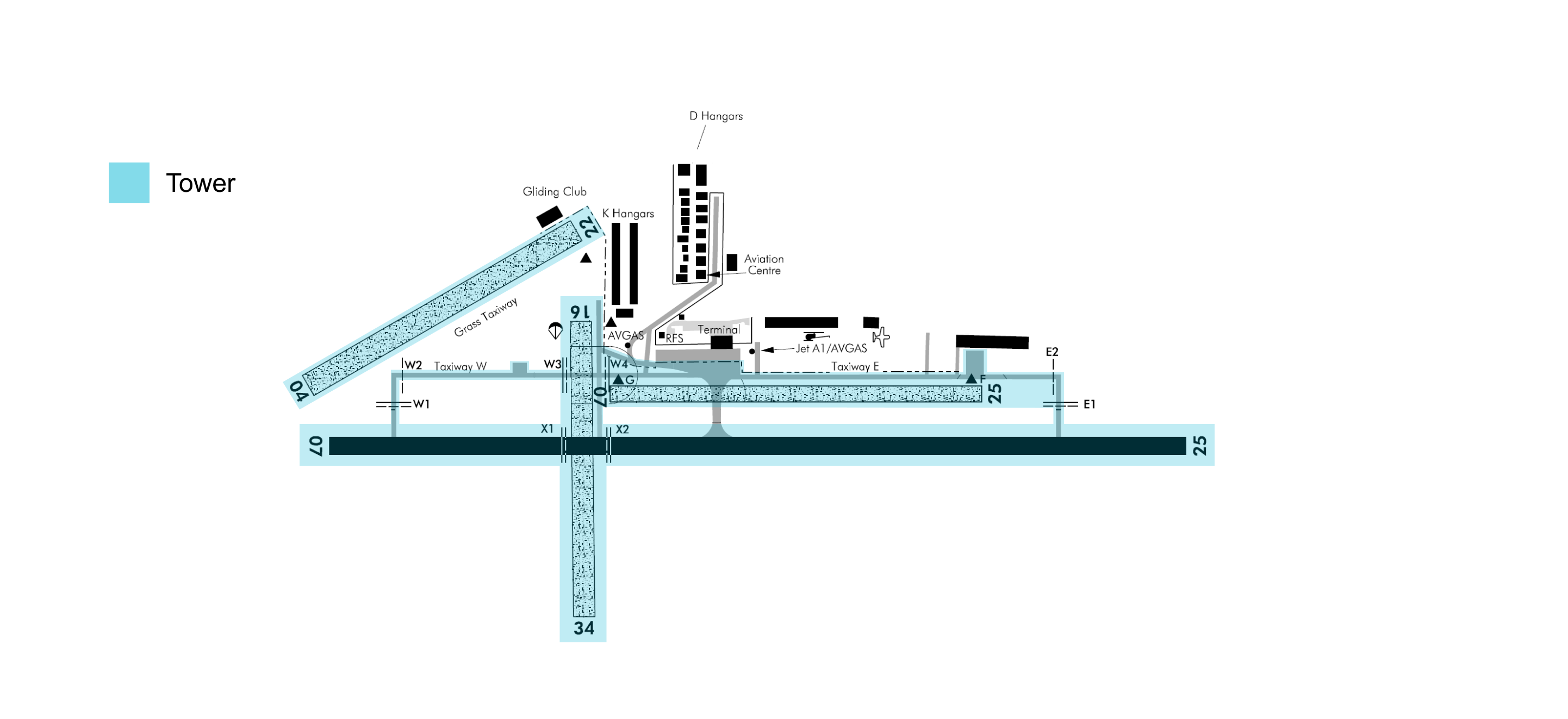Control Positions and Navaids
| Position Name | Shortcode | Callsign | Frequency | Login ID | Usage |
|---|---|---|---|---|---|
| Tauranga ADC | TTG | Tauranga Tower | 118.300 | NZTG_TWR | Primary |
Layout
Tauranga has four gates on the main apron and is home to over 20 private hangars. Tauranga also hosts multiple flight training organisations, which provides training for fixed wing, helicopter and gliders.
Tauranga has six Runways in total. While only four are regularly used, the remainder are used when required or when special operations are in place.
Runways
| Runway Designator | Length (m) | Type |
|---|---|---|
| 07 - 25 | 1825 | Bituminous |
| 07 - 25 | 750 | Grass |
| 04 - 22 | 640 | Grass |
| 16 - 34 | 575 | Grass |
Sealed 07/25 is always issued to aircraft with a gross weight of 5500kg or more, and can be issued to smaller aircraft on request. Gliders & helicopters are not permitted to use the sealed runway.
Grass 25/07 is always issued to light aircraft with a gross weight of 5500kg or less and cannot be issued to Category B/C/D aircraft.
Grass 04/22 Glider Operations Only
The Airport Company has an agreement with the Gliding Club prohibiting use of Grass 04/22 for aircraft other than gliders and tow planes.
General Rules of Thumb
Movement Areas
Aircraft should contact ATC before entering the movement area and should state their location after contact has been established.
Aircraft who require taxi to the fuel pumps from any of the eastern hangars or Aero Club can do so without contacting ATC, provided they stay outside the Movement Area - as indicated by a dashed red line along Taxiway E.
Rule Of Thumb
All arriving aircraft should keep seawards of the coastline, allowing for departing aircraft to pass on the land-side of the coast. This general rule is a safe way to keep traffic flowing efficiently in and out of the aerodrome.
VFR Arrivals & Departures
All arriving VFR aircraft should reference the preferred VFR arrival procedures as listed in the NZ AIP.
Standard VFR departures should be issued where possible, to ensure the safe and efficient flow of traffic is maintained.
All departure traffic should be advised to remain 1500 feet or below, unless otherwise stated on the departure chart.
Standard Overhead Join
With permission from Tauranga Tower, traffic are permitted to conduct a standard overhead join, typically beginning from the East or West.
Approaches
Runway 07
All arrivals terminate at RUSTA or MORTA, which are the IAF(s) for the RNP approach.
Missed Approach
In the event of a missed approach, aicraft should be instructed to carry out the published missed approach procedure. This will have the aircraft climbing to 2000 feet, turning direct to LETGU, before holding at RUSTA 5000 feet or above. Aircrft can then be re-cleared for the RNP approach, or cleared a visual approach, should the conditions be suitable.
Runway 25
Approaches
All arrivals terminate at UBSET or TODAN, which are the IAF(s) for the RNP approach.
Missed Approach
In the event of a missed approach, aicraft should be instructed to carry out the published missed approach procedure. This will have the aircraft climbing to 2000 feet, turning direct to LETGU, before holding at UBSET at 4000 feet or above. Aircrft can then be re-cleared for the RNP approach, or cleared a visual approach, should the conditions be suitable.
Departures
Procedure Assignment
Our Controller Clients will usually assign the most suitable departure for that aircraft's flight plan and aircraft type.
Parallel Operations
If both the sealed and grass runways are occupied, and both aircraft are ready for departure, the aircraft on the grass runway should be instructed to takeoff first. This avoids the need to wait two or three minutes due to wake turbulence separation. The aircraft who departs first should be instructed to make an early turn to allow successive departure of the waiting aircraft.
Warning
Furthermore, simultaneous parallel operations on sealed and grass runways 07/25 are permitted only for aircraft 2300 kg or less in VFR conditions and when ATC is on duty.
Visual Departures
Info
Visual departures are almost never given in Tauranga, due to the SID being cancelled early by Bay Approach. Most aircraft will typically be cleared direct the transition fix, traffic depending. Visual Departures can be issued if requested.
Use of Taxiways and Holding Points
Taxiway E runs parallel to Grass 07/25, for almost the entire length of the apron area.
Upon landing, inbound aircraft shall be told to either taxi to the apron or hold short of the grass due to departing/arriving traffic. If the latter has to occur, the aircraft must be instructed to taxi to A1/A2 and hold short of Grass 07/25.
Grass Hold Short Points
There are various intermediate holding points specifically for the grass runways. Usually, these hold short points are located on hard-standing surfaces.
-
Grass 07 -
Golf -
Grass 25 -
Foxtrot -
Grass 16 -
W4from the apron side, orW3from the Sealed 07 threshold side.
Sealed Hold Short Points
-
Sealed 07/25 (from the Main Apron) -
A2orA3 -
Sealed 07 (light aircraft) -
W1orW2 -
Sealed 25 (light aircraft) -
E1orE2
Info
When grass 04/22 is in use, aircraft using Taxiway W should hold short at W2 to prevent an incursion.
Other Operational Notes
Crane Operation
Danger
Tauranga Port is Adjacent to Tauranga Airport and operates Multiple cranes up to 361 ft AMSL at 1.5 to 2.0 NM from Runway 07 Threshold.
VFR Aircraft tracking Hunters Creek or Mt. Harbour Entrance should not commence their turn until 500ft AGL.
